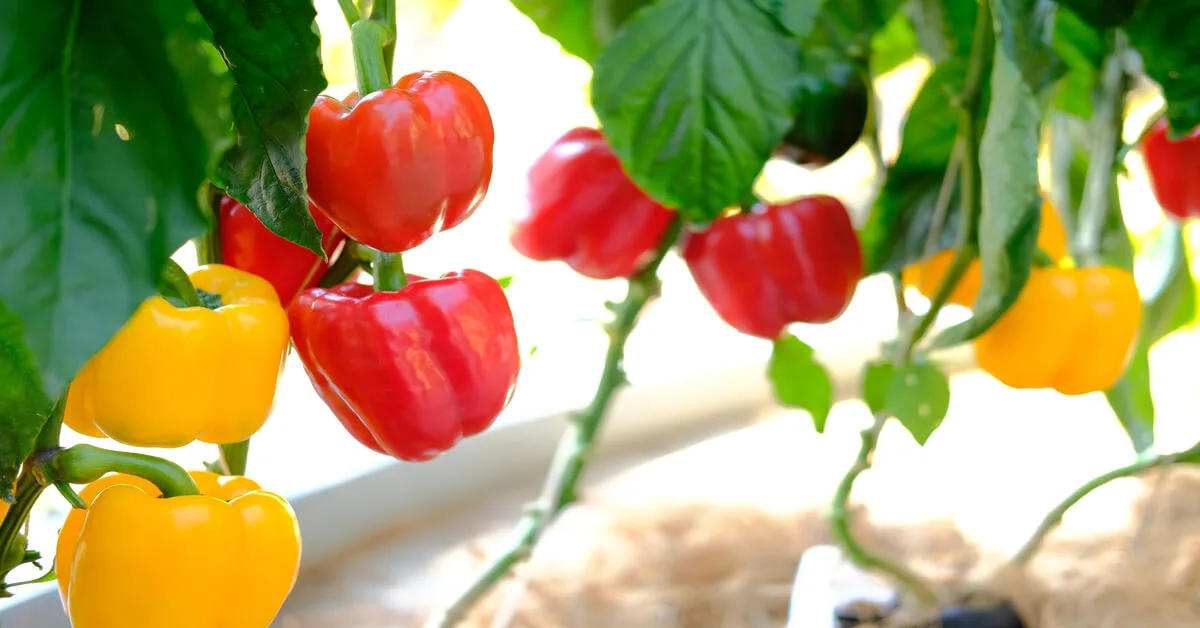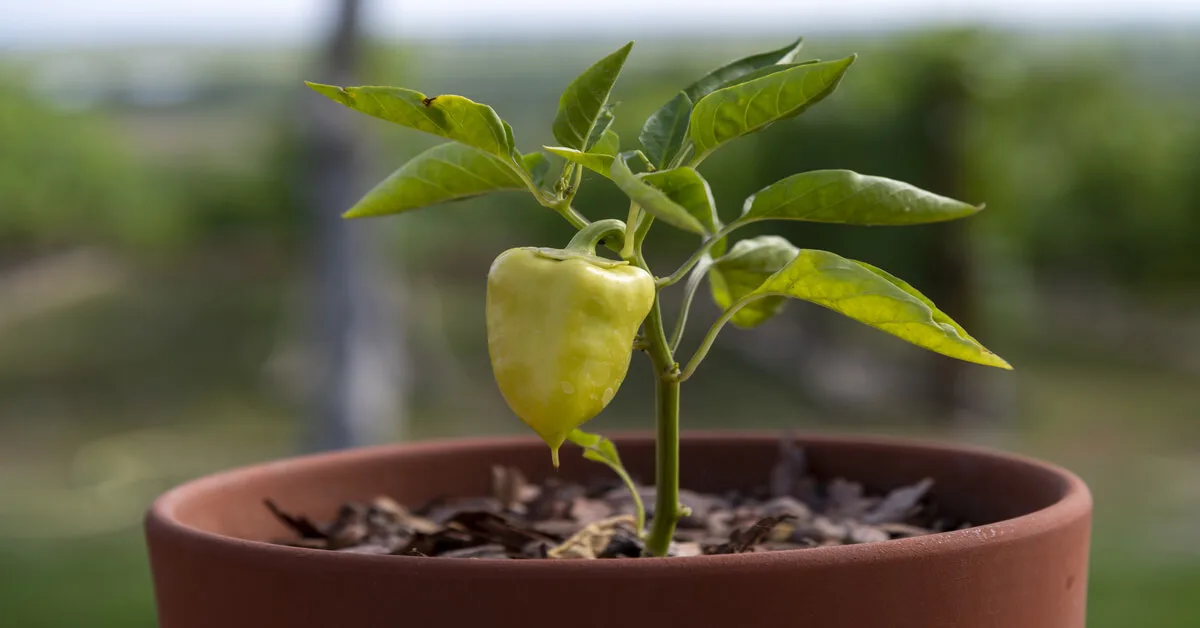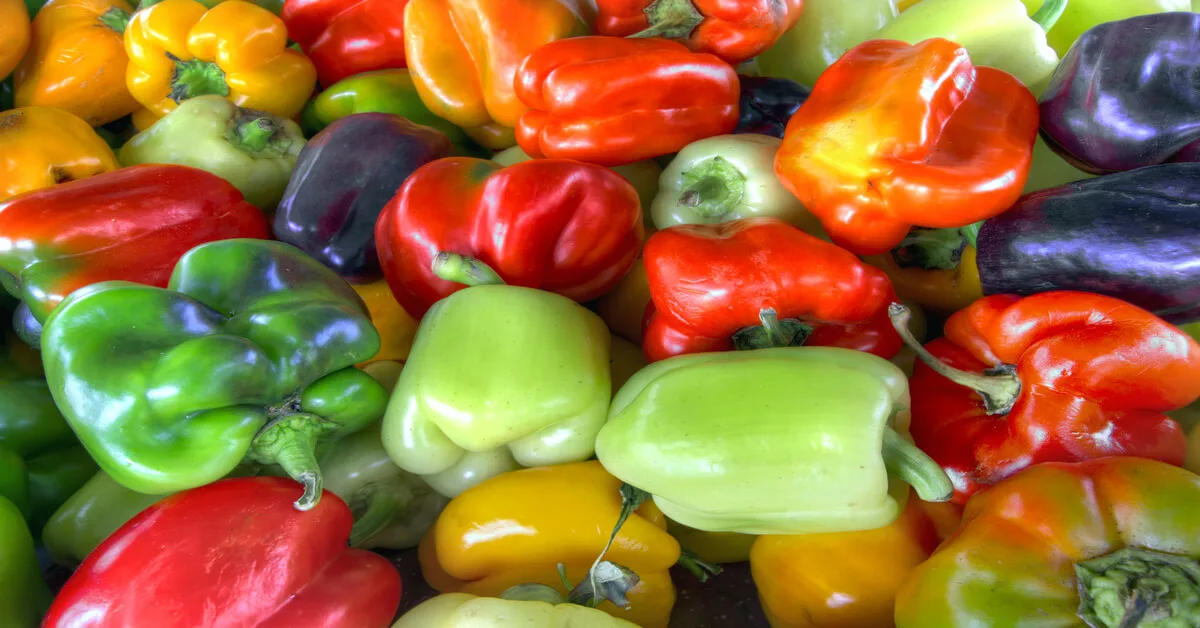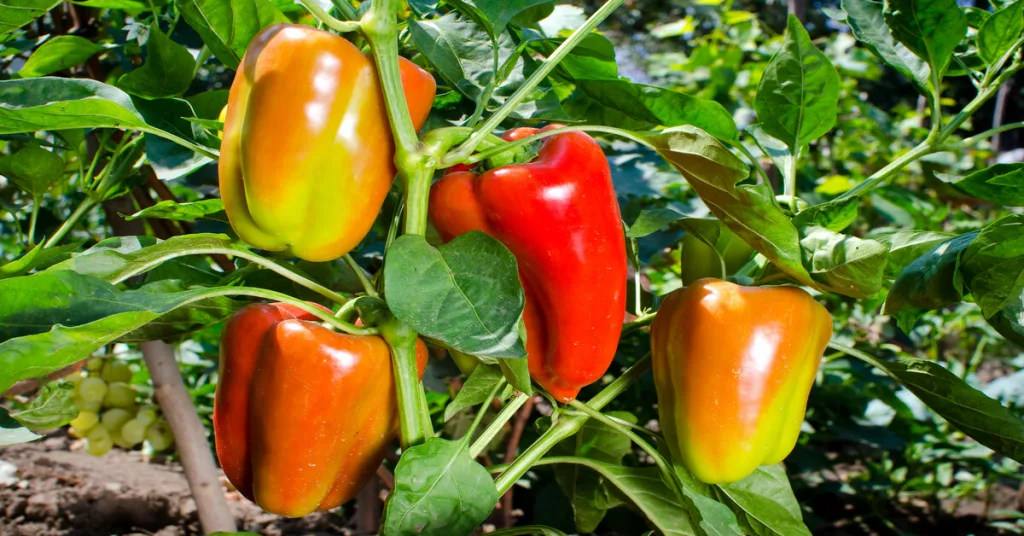Bell peppers (Capsicum annuum), also known as sweet peppers or capsicums, are delicious and versatile vegetables that can be used in a wide variety of dishes.
Part of the nightshade (Solanaceae) family, which includes close relatives such as the tomato, eggplant, and potato, bell peppers are considered fruits botanically but treated culinarily as vegetables.
The Capsicum annuum species also includes chili pepper varieties such as jalapenos and cayenne peppers. Most sweet peppers, however, lack the gene that produces capsaicin, giving them a 0 on the Scoville heat scale.
Although they are not spicy, bell peppers offer many nutritional benefits and are a good source of vitamins A and C, as well as many other important antioxidants and nutrients.
Below, we’ll go over everything about how to plant, grow, and care for bell peppers.
Bell Pepper Plant Care

Bell peppers are fairly easy-to-grow plants if you live in an area with plenty of heat and sun. In colder climates, they may not bear fruit until late summer.
For those with limited space, bell peppers also make excellent container plants. Unlike tomatoes, bell peppers are compact and do not require extensive staking or trellising.
Freshly grown bell peppers can be sliced and added to salads, grilled or roasted and served as a side dish, or chopped and used in soups, stews, and casseroles. They can also be stuffed with rice, ground meat, or vegetables, and baked in the oven.
With the proper care and attention, you can successfully grow your own bell peppers and enjoy their sweet and tangy flavor.
Soil
Bell peppers prefer well-draining, loamy soil with a pH between 6.0 and 6.8. The soil should also be rich in organic matter such as compost.
Before planting, it is important to test the soil to ensure that it has the right pH and nutrient levels.
Adding lime or sulfur to the soil can help adjust the pH to the ideal range for bell peppers.
Watering
Bell peppers require regular watering (~1-2 inches per week) to ensure the soil stays moist but not waterlogged. Plants should be watered deeply and consistently to provide enough moisture to the root zone.
Overwatering can lead to root rot, so it’s important to allow the soil to dry out slightly between waterings.
Avoid getting leaves wet, as this can encourage the growth of fungal diseases.
Lighting
Bell peppers require full sunlight to grow and thrive. In general, they should be grown in a location that receives 6-8 hours of direct sunlight per day.
If growing indoors, place bell peppers near a sunny south-facing window or under artificial grow lights.
Insufficient lighting can lead to stunted growth and poor yields.
Humidity & Temperature
Bell peppers prefer warm, humid conditions. They should be grown in an area with daytime temperatures between 70-85°F (21-29°C).
Bell peppers may abort and drop flowers if daytime temperatures exceed 85°F (29°C) or if nighttime temperatures drop below 60°F (15°C). [1]
Bell peppers prefer relative humidity between 60 and 70%.
To increase humidity around the plants, you can mist them with a humidifier, but ensure plenty of ventilation to prevent fungal diseases from developing.
Fertilizing (NPK)
Most potting mixes will contain enough fertilizer to provide for the plants for about two weeks.
If your mix does not contain fertilizer, you can prepare the soil with a fertilizer with a ratio of 5-10-10 or 8-16-16 NPK (with half as much nitrogen as phosphorus or potassium).
Once the plants are established, fertilize every 2-4 weeks, and switch to a high-potassium fertilizer 9-15-30 NPK ratio once flowering begins.
Make sure to water after fertilization to help the fertilizer dissolve into the soil. Watch out for overfeeding and fertilizer burn, and adjust fertilization accordingly.
Organic gardeners can use a combination of fish emulsion, kelp meal, or bone meal to provide similar results.
Diseases & Pests
Some common diseases that affect bell peppers include bacterial leaf spot, mosaic virus, blossom-end rot, and pepper leaf curl virus.
Bacterial leaf spot is caused by a bacterial infection and can cause dark, water-soaked spots to form on the leaves of the pepper plant.
Mosaic virus, which is spread by insects or through contaminated soil, can cause the leaves of the pepper plant to become mottled and distorted.
Blossom-end rot is a common problem in bell peppers and tomatoes and is caused by environmental and nutritional stresses.
Pepper leaf curl virus affects bell peppers and other members of the nightshade family, such as tomatoes and eggplants. The virus spreads by insect vectors such as whiteflies and aphids.
Symptoms include the bell pepper plant leaves curling and turning yellow, as well as stunted plants. In severe cases, the virus can cause the plants to produce small, misshapen fruit. [2]
As for pests, bell peppers can be affected by aphids, white flies, thrips, fungus gnats, cutworms, and spider mites.
Remove and destroy infected plants and plant debris to prevent diseases and insects from spreading. Avoid overwatering and getting leaves wet, and use disease and pest-resistant cultivars whenever possible.
If necessary, use a fungicide or insecticide to control diseases or pests.
Days to Maturity
Most sweet peppers take 70-85 days from transplanting to develop mature fruits, with an additional 14-21 days to fully ripen.
For a timelapse video of bell peppers from seed to mature fruits, see this video.
Harvesting
When harvesting bell peppers, wait until they are fully ripe before picking them. Bell peppers will be larger and sweeter when they are fully ripe.
To tell if a bell pepper is ripe, look for firm and smooth peppers with glossy skin. In general, green peppers are unripe, while red, yellow, and orange peppers are ripe.
To store bell peppers, place them in a plastic bag in the refrigerator. This will help keep them fresh and prevent them from drying out.
The bell peppers will stay fresh for about a week in the fridge, or several months if washed, sliced, and frozen.
Bell Pepper Plant Stages

Bell pepper plants go through several stages of growth, from germination to mature plants.
- Germination (0-14 days): The seeds begin to sprout and develop their first true set of leaves. This stage usually takes about 2 weeks.
- Vegetative (14-50 days): After germination, the plant begins to grow leaves and stems and develop a root system. After 6 weeks, plants should have developed several sets of true leaves and may be transplanted into a larger container or hardened off for the outdoors if starting seed indoors.
- Pollination, Flowering, and Fruiting (50-95 days): Bell peppers are self-pollinating and will produce flowers that will eventually shrivel and turn into fruit pods. This stage can last for several weeks as bell peppers reach their mature size.
- Ripening (95-115+ days): The peppers will begin to turn from green to red, yellow, or orange (depending on the variety). Once the peppers are fully ripe, they can be harvested.
How to Grow Bell Peppers from Seed
Bell peppers can be started from seeds indoors 6-8 weeks before the first frost to give them a head start on the growing season. To grow bell peppers from seeds, follow these steps:
- Start by filing small pots or seed trays with a high-quality potting mix designed for starting seeds. Place seeds at a planting depth of ¼ inch (0.6 cm) inside the potting mix.
- Place the pots or trays in a warm location that receives plenty of indirect light or use a grow light. Bell peppers need warmth and moisture to germinate, so keep the soil moist and consider using a heat mat to maintain soil temperatures of 70°F (21°C) or above.
- Once the seeds have germinated and seedlings have emerged, move the pots or trays to a location that receives full sun for at least 6-8 hours a day. Gradually acclimate the seedlings to the sun by increasing the amount of time they spend in direct light every day.
- When the seedlings have developed several sets of true leaves and are about 6 inches (15 cm) tall, transplant them to a larger pot or into your garden. Wait until the last frost has passed and soil temperatures are above 55°F (13°C) before transplanting outdoors. You may also want to gradually harden them off to outside conditions rather than directly transplanting them.
- If you are planting bell peppers in rows, space the plants 18-24 inches (45-60 cm) apart within rows and 24-36 inches (60-91 cm) between rows. For larger varieties, consider giving them even more space to spread.
Growing Bell Peppers in Pots

Bell peppers can be grown in pots as long as the pots are large enough to accommodate their root system. Here are some helpful tips for growing peppers in pots:
- Choose a pot that is at least 12 inches (30 cm) in diameter and has drainage holes to allow excess water to drain away from the roots.
- Use a high-quality potting mix that is specifically designed for growing vegetables.
- Place the pot in an area that receives full sun for at least 6-8 hours, preferably a south-, west-, or east-facing window. Bell peppers need plenty of sunlight to grow and produce fruit.
- Water the plants regularly, keeping the soil evenly moist. Use a watering can or hose with a fine spray to avoid damaging the plants or getting leaves wet.
- Prune immature peppers and leaves early in the season to promote larger and more flavorful fruit. Fertilize plants every 2-4 weeks using NPK 5-10-10 fertilizer and switch to 9-15-30 NPK when fruits begin to set.
Bell Pepper Companion Plants
Some common companion crops for bell peppers include tomatoes, herbs (e.g. basil, dill, chives, parsley, etc.), onions, carrots, beans, peas, lettuce, spinach, corn, and marigolds.
Basil helps to repel pests and tomatoes provide shade for bell peppers.
Alliums such as onions and tubers such as carrots help improve the soil by adding nutrients and promoting good drainage.
Beans and peas are nitrogen-fixing and will improve the soil quality for peppers.
Spinach, lettuce, and chard help form a ground cover, which drowns out weeds and keeps the soil cool and moist.
Corn can serve as a windbreaker and sun-shield, preventing peppers from developing sunscald.
Marigolds and other flowers can help to attract beneficial insects and deter pests.
Additionally, companion planting can also help to optimize the use of space in the garden and improve the overall appearance of the planting area.
Bell Pepper Varieties

There are many different varieties of bell peppers, and they come in a range of colors, shapes, and sizes. Some common varieties include:
- Green bell peppers: These are the most commonly available variety and have a crisp, grassy, tangy flavor. They are typically harvested when they are still green, but if allowed to ripen, they will turn yellow, orange, or red.
- Red bell peppers: These are bell peppers that have been allowed to fully ripen on the vine, resulting in a sweeter, more flavorful pepper. They are often used in salads and as a garnish due to their vibrant red color.
- Yellow bell peppers: These are similar to red bell peppers, but have a slightly milder flavor and a bright yellow color.
- Orange bell peppers: These are similar to red bell peppers, but have a slightly more robust flavor and a bright orange color.
Bell peppers also come in other rarer varieties:
- Purple bell peppers: These are bell peppers that have a dark purple or black color and a slightly sweet, smoky flavor. They are often used in salads and as a garnish.
- White bell peppers: A stunning and rare cultivar, these bell peppers produce white translucent fruits that mature to a cream yellow and finally red. The peppers have a rich and sweet flavor excellent for a salad, stuffing, or cooking.
Overall, the choice of bell pepper variety will depend on the specific use and the personal preferences of the grower or cook.
References:
[1] Author unknown, (n.d.), Peppers. Iowa State University Extension and Outreach. Retrieved December 7, 2022, from https://store.extension.iastate.edu/Product/Peppers-PDF.
[2] Goldberg, N. (1995, August). Chile Pepper Diseases. New Mexico State University College of Agricultural, Consumer, and Environmental Sciences. Retrieved December 7, 2022, from https://pubs.nmsu.edu/_circulars/CR549/.

